Updated 23 February 2023
This is a comprehensive continuation of problem resolution of the ESi thermostat which can be found HERE.
Update
Due to the imminent installation of a new boiler with Priority Domestic Hot Water, I will be able to control the water temperature using the unvented cylinders integral thermostat making the ESCTDE/B redundant and therefore I have removed it.
Problem
After the cylinder thermostat was installed, I noticed that the boiler would fire up outside of any scheduled times, checking the programmer settings and wiring, I deduced that the supply to call for heat to the Hot Water Valve was being controlled by the ESCTEDE/B.
I spoke to ESi technical and they confirmed this to be the case when the cylinder thermostat was configured for legionella mode. In this mode, the internal timer of the ESCTEDE/B will call for hot water, (irrespective of the time of day or programmer setting) until the measured water temperature is at or above 60 deg C for 1 hour in order to kill water borne bugs.
As a result of this, I reluctantly disabled the legionella function.
After I received the prompting comment from a blog reader, I thought I would look at a circuit which would only allow the hot water to call for heat based on the programmers scheduled time setting, however, should the legionella mode timer be internally activated, this would proceed as normal, but only within the programmers scheduled time slots.
The simplified schematic below shows this can be accomplished using an interposing relay as a switch for the motorised valve trigger.
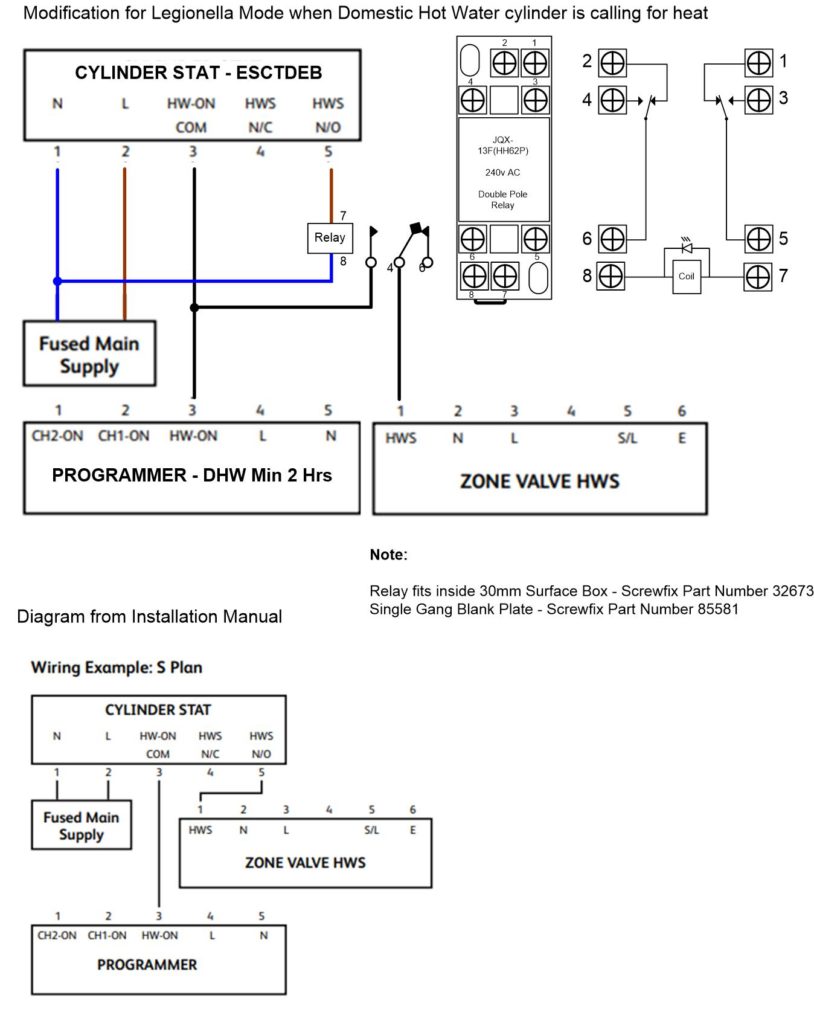
Solution – Method of Operation
When the programmer calls for Hot Water, a switched live is sent to the ESi controller HW -ON -COM terminal and also to a Normally Open terminal of a 230v AC Relay contact, the common of the relay contact is connected to the motorised valve (Brown Wire).
When the ESi receives a switched live to the HW-ON-COM, the ESi LED illuminates and an internal connection is made and a switched live appears on the HWS N/O terminal, this output is now wired directly to the relay coil, rather than the motorised valve.
The result of this modification is that when the HW programmer calls for heat, the relay will energise and supply the motorised valve with a switched live from the programmer, should the ESI enter legionella mode, the relay will energise or remain energised depending on the programmers time setting, however, if the programmer is not calling for heat, the switched supply to the motorised valve will no longer be present and the valve will close turning off the boiler.
The advantage of this arrangement is that the boiler firing is dependent on the programmers scheduled times set by the user, rather than the ESCTEDE/B doing this at random times.
The main thing to note is that the legionella setting from the ESCTEDE/B will not reset unless the water, reaches and maintains, a temperature of 60 degrees for 1 hour, this means that the programmers time window must be greater than 2 hours making the assumption the tanks contents will reach temperature in the first hour and maintain this in the second hour.
Obviously the boilers hot water temperature setting must be greater than 61 degrees for this to work.
Modified ‘S’ Plan Wiring Schematic to include Relay Control
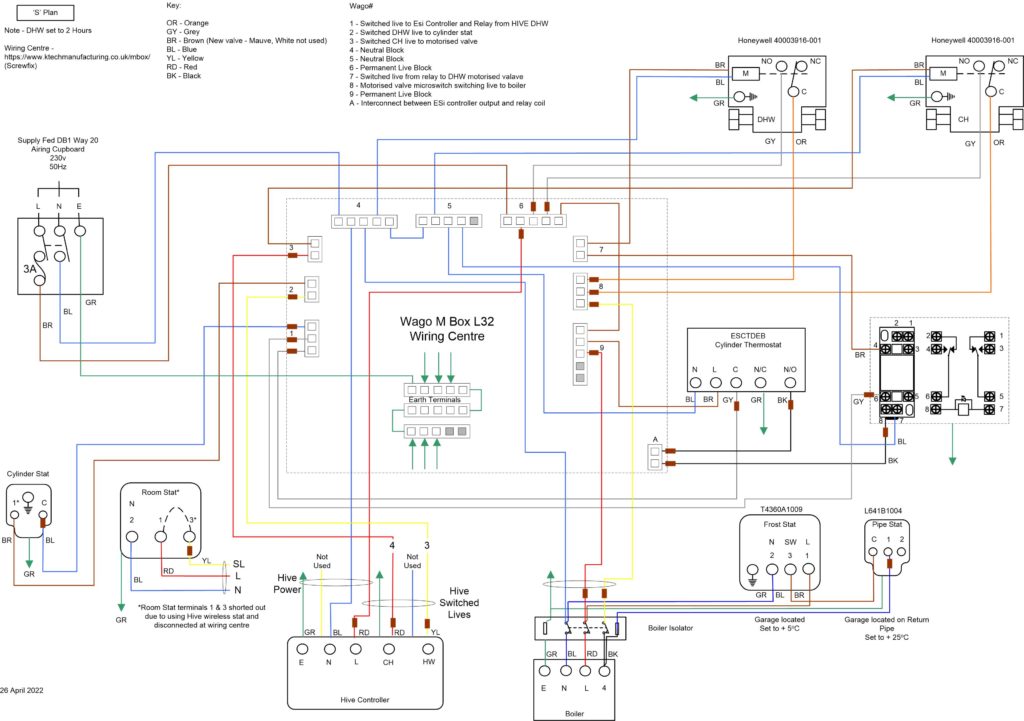
My existing central heating wiring centre was the original one and modified when I fitted the ESi and as you can see it was a little bit ‘busy’ and desperately in need of a tidy up!
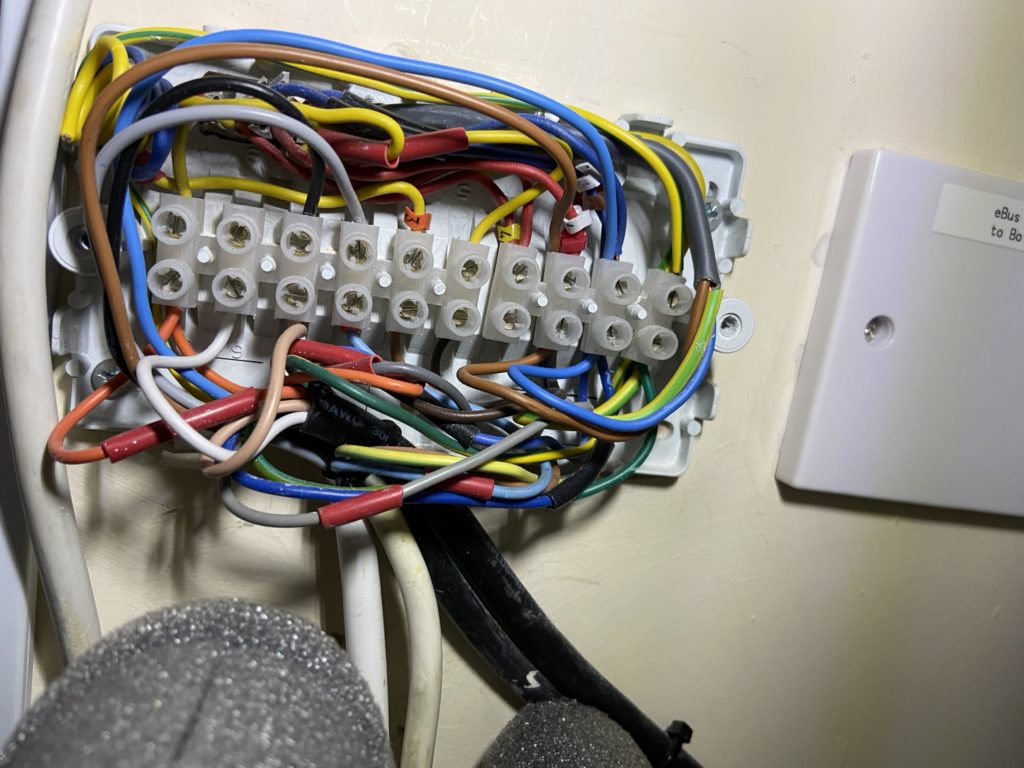
Looking around for a replacement wiring centre, I saw that a local Screwfix had one in which uses Wago connections rather than traditional terminal strips, the main benefit of this is the tool less connection of wires and a greater number of connection terminals avoiding doubling up of wires which makes installation messy and fault finding difficult.
The Screwfix part number is 621HV and the product is a Wago L32 Terminal Junction Box.
Even though the L32 had a lot of connections, I still needed additional connections for the earth wires and a cross connect marked as connector ‘A’ in the schematic.
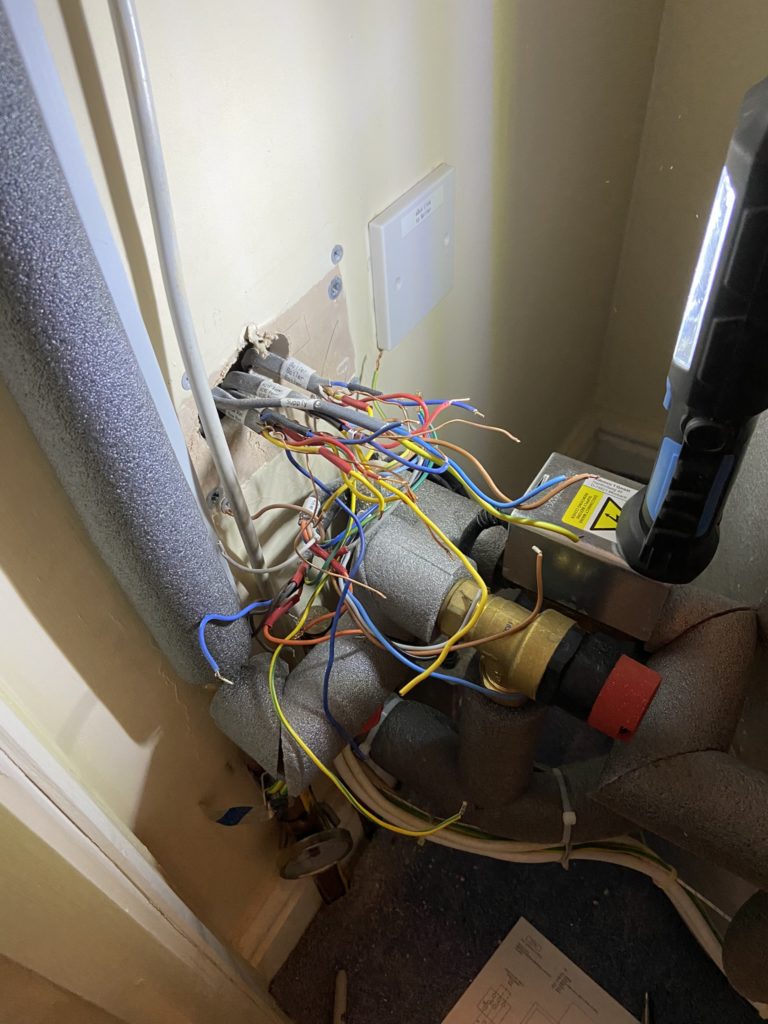
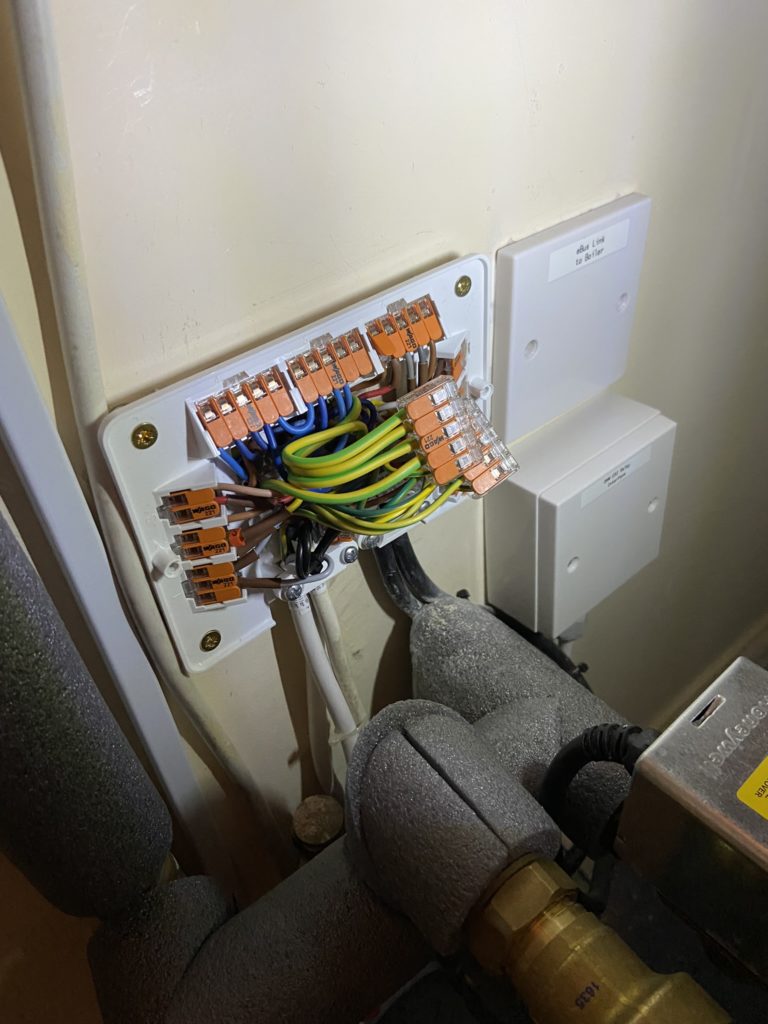
The completed Wago L32 wiring centre is considerably neater than the one it replaced, the schematic terminal connections are faithfully recreated within the L32 to aid fault finding or future modifications if required.
Once this was done I changed the legionella setting to operate every 7 days, the installation guide on how to set this up is HERE.
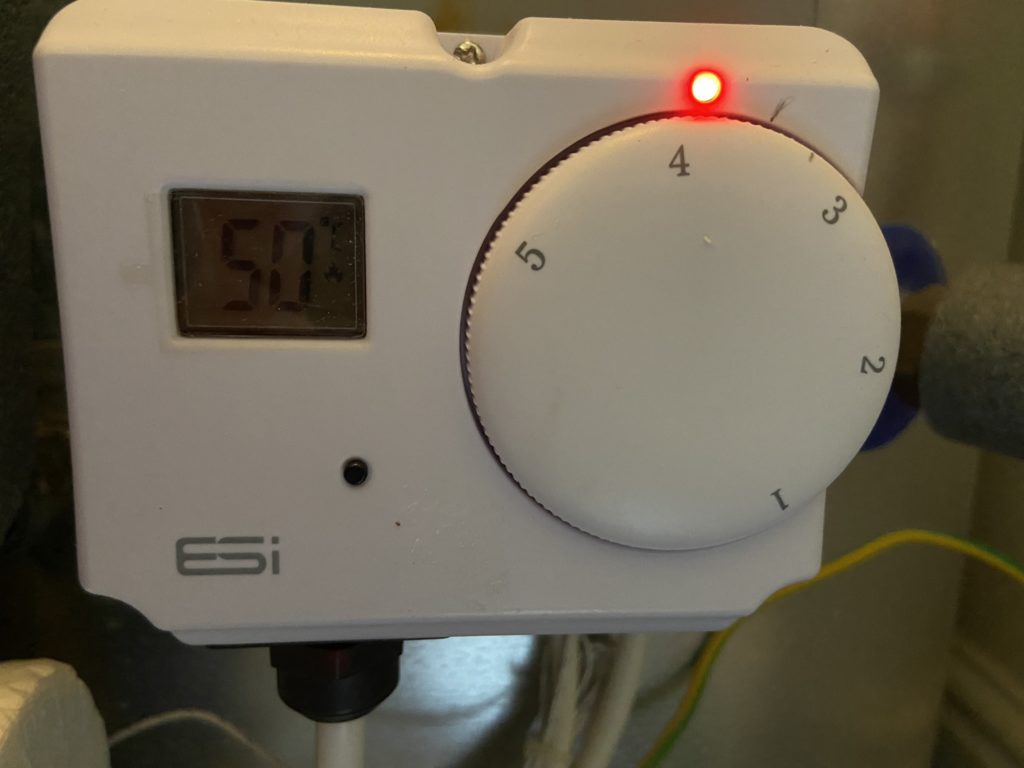


Hello
I got exact same boiler and also purchases the ESI device thinking it be an easy setup. Saying that, you had to do a lot of modification.
Is the part two that needs to be followed?
Not sure if should go for it …
I got Ideal system boiler and Ideal Halo Heat & system WiFi thermostat which uses S Plan to somehow have CH on lower temperature using OpenTherm and then rank up on DHW when needed.
I just wanted to have the digital display to have an output of the cylinders temperature etc. so maybe it reads more accurate to thermostat etc.
In dilemma now what to do 🙁
Hi,
There is a Part 3, remove ESi.
Ideals Priority Domestic Hot Water (PDHW) can deliver up to 80oC, therefore, I didn’t need to retain the ESi as this was really for legionella protection and the display was not a true reflection of the tanks water temperature after heating due to stratification.
Over a few days I adjusted the cylinders thermostats temperature control to give me a calibrated 62oC, the method I used was to run the hot tap past a digital thermometer which was only a few pounds from Aliexpress after the cylinder had been reheated, (test, adjust, repeat).
Although not digital, you could use an analogue temperature gauge in a dry pocket on the tanks hot water outlet, this would give a quick indication of the waters temperature without the faff of measuring running water.
If you do remove the ESi, make sure the PDHW switched live to the boiler goes though the cylinders thermostat, not the feed to the motorised valve, the reason for this is if the motorised valve sticks when the cylinder stat is satisfied, the boiler will continue pumping heat into the cylinder, which is not good.
All the best whichever you decide.
actually:
Since my smart thermostat, has got a DHW timer and CH timer. Would I still need this digital display?
It is Ideal Halo heat & System wifi thermostat.
Uses opentherm via Internet weather app.
Currently set my Ideal system boiler to 55c (it has only one temperature knob) and hope that cylinder stat will be satisfied and shut off when done.
Hello Ian
I have not installed the ESI afterall.
God knows why I even purchased it, just wanted a digital output to what the temp is.
As i got a new ideal vogue system boiler as well as ideal
Halo heat and system wifi thermostat – dont u think the ESI is not even relevant?
Maybe i was overcomplicating it?
Hi Ian
One thing I am not understanding is, how to calibrate the boiler so it runs in condensation. On the boiler I turned the temp down to 55oC
Now, i know the cylinder stand most likely is set to 65oC and wonder how the ideal boiler will manage to satisfy that with the 55C?
Or are we saying because of the HW Priority the boiler will go on higher temp?
Furthermore, am I expected to leave the hot water ON all time? That be expensive 🙁 unsure how to regulate it
My ESi served a purpose, but with the Ideal Vouge it was simply not needed, you weren’t overcomplicating things, the way we use/don’t use things evolve as we get a better understanding.
It depends on how your installer has set up the boiler wiring, in central heating mode the 55c would be the maximum flow temperature in heating, (I have a weather compensation sensor rather than Halo, so my display is slightly different to yours).
In DHW mode the boiler, (depending on wiring) should go into high fire and deliver water to the cylinder at a higher temperature that 55c, for example my unvented cylinder typically takes 20minutes at 80c to heat the water before turning off based on the cylinder thermostat set at 62c.
This the display on my boiler when PDHW is calling:
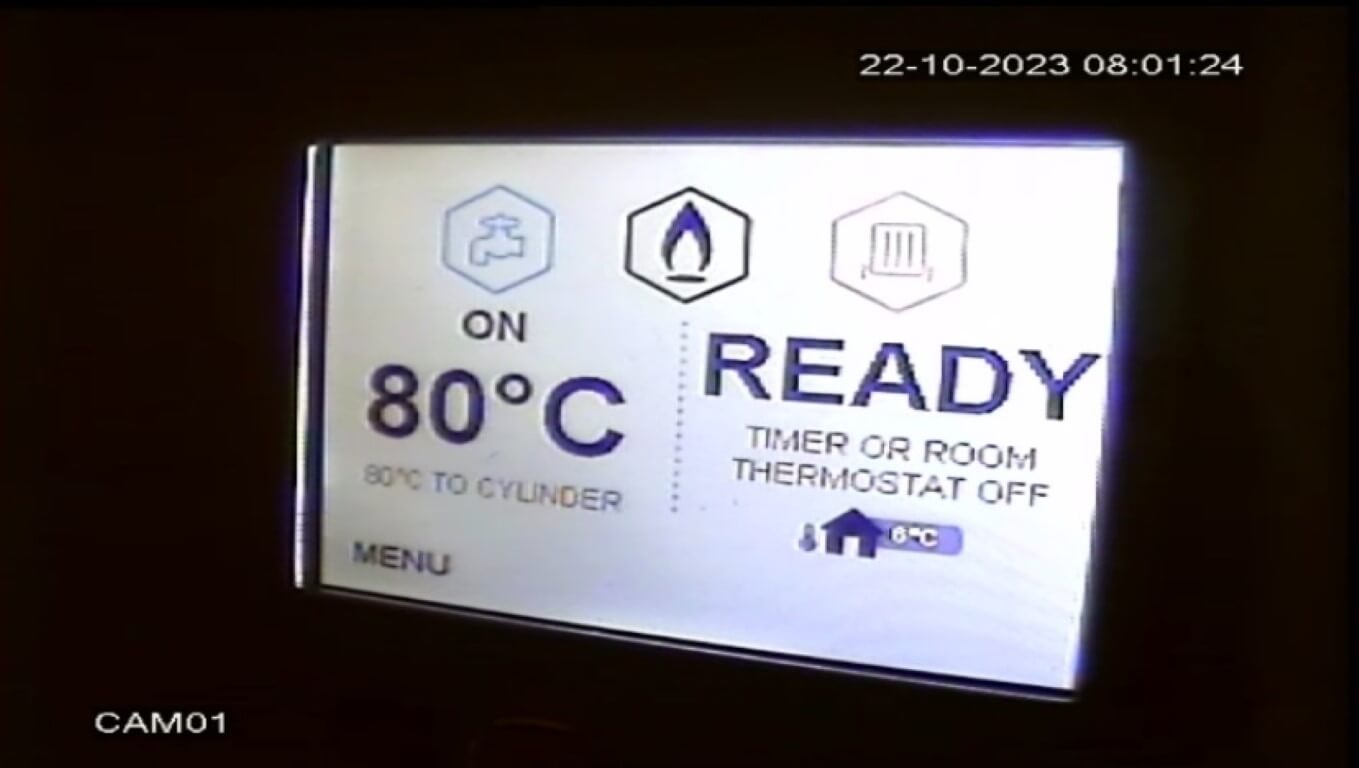
Anything at 55c or below on the flow temperature will mean the return water temperature will be in the condensing range, if you can get lower than 55c and still be warm, that’s a bonus but depends on the size of your radiators.
Within the boiler are two switched live electrical connections, one for CH the other for PDHW, the difference is that a switched live to the PDHW will override the CH temperature and the boiler will ramp up to a maximum of 80c (this temperature can be reduced in the menu), to stop the radiators getting this hot, the CH motorised valve will be closed for the duration of the PDHW cycle, so if you do need CH on, move the hot water schedule so they don’t overlap.
On the system here, the motorised valve to the hot water cylinder is a normally open version, and closes when CH is asking for heat.
Hi Ian
I guess ur also on Ideal System Boiler?
Saying that, on my system boiler I DONT get that display as you do when I call for HW on demand.
The ideal Halo Heat & Sytem did not require to change any zone valves to NO or NC. As apparently it is clever enough to operate the valves independently dependig what I am asking for .eg HW or CH or both.
At moment on system boiler i set it to 55oC.
When I called for HW for an hour , i seen it as 57c.
Maybe should have left longer.
Unfortunately cos of old cylinder tank, i wont expect to heat up as quickly.
Hi
If you can let me know the exact model of the boiler, (usually a small label on the underside of the boiler), I’ll have a look at the manual so I can better understand how your system can be setup.
Hey Ian
Thanks for taking ur time into this.
The boiler is: Ideal Vogue Max s18
Smart thermostat: Ideal Halo Heat & System WiFi
(https://idealheating.com/products/halo-heat-system-wi-fi)
Current max temp on boiler is set: 55oC
Max temperature on unvented cylinder: no clue! Not sure where I can check that either, do u know?
I just places CH to 20oC and it heated the radiators until it reached the room temperature. The boiler display showed round 45-55oC.
Even when I placed the HW on Demand for an hour to ON, there was no display on boiler to say “HW is calling” or to see the temp going above 55oC.
I also pressed on MENU on boiler and noticed some settings and clicked on SENSOR READING and showed the following;
– water pressure: on
– CH switched live: on
– flow temperature: 55C
– return temperature: 47C
– thermal fuse: on
– flame: on
– DHW switched live: off
– open therm: on
– low voltage switch: off
Unsure it the DHW switch live should be ON?
It seems not to change status even when HW was set to on. Maybe its normal behaviour or wrongly wired?
According to the ideal smart thermostat it was all color coder and simple to follow. I added a link to product above.
Hi,
Thanks for the links and info, it appears that the control data from the Halo replaces the basic switched lives to the CH and PDHW, (CH is internally linked for the Halo to work).
Halo offers a high level of output control using opentherm connectivity, hence the lack of a switched live on the PDHW.
As a test, set the HW schedule was ON and turn the hot water cylinders thermostat temperature up, the green Hot Water LED should come ON, on the smart wiring centre by the tank after the motorised valves have moved to the correct position.
I cant find where it says what the water temperature will be, but if the boiler is working hard, you will hear an increase in fan noise, and in the menu the gas valve will be 100%, it may take time to ramp up to this setting though.
Is the issue you have that the water is not hot enough?
Hi Ian
Good shout, I will give that a go to test.
So far I tested:
As soon as I put the DHW on for like 10min, I could already feel the hot water coming through the tap.
The water was hot enough to hold my hands in hot water and not have burned. Yet, I need to find out what temperature is the Cylinder Tank set to, unsure where I can find that out. Please advise.
As mentioned, on the temp flow: I turned it down to 55oC , although when I clicked through the Menu on boiler there was a Max Flow Temperatur set to 80oC which I found confusing because I thought the temp know I turned down to 55oC hmmm
Anyway, turned the Max flow temp dow to 70oC
Unsure what this will be used for?
Are you saying that the boiler should go above the 55oC to satisfy the cylinder tank? Cos as of now, have not seen it in action.
So, yeh. To answer ur question: hot water seems to come through. As I have not moved in yet and I am renovating, need to see how much I need to leave the DHW on until cylinder is satisfied. I hope it will ask boiler to ramp up to heat cylinder high up and then go to OpenTherm when satisfied.
At least that is what I been told by Ideal Sales team.
OK,
I would put the maximum flow back to 80c as it wont do any harm there, the 55c is also a maximum temperature setting, but this is only for the water to the radiators, typically the boilers flow temperature will be lower, only reaching the higher temperatures when the outside temperature drops.
Your hot water cylinder will have a thermostat fitted or they may have used the one that comes with the tank, is there a make/model on the tank as this is where the final water temperature is set.
I don’t have a Halo system so I’m making an assumption that when HW is calling, the CH valve will close and the HW valve will open and the boiler will ramp to high fire in order to recharge the cylinder with water up to a temperature of 80c.
If you can hold your hand under the hot water, this means its around 40/42c.
UPDATE- I’ve discovered that Halo does not support Priority Domestic Hot Water, so it appears the hot water temperature is based on the maximum flow temperature of the central heating as you originally surmised.
Hello Ian
I just read hour updated comment and I am speechless, upset and angry! I purchased this in believe that it does support PDHW because the boiler supports it and I am sure the even told me that on phone.
Now its all too late. Its all setup and installed and no point of return. I just need to get my head around this and understand how it works and how to utilise it in most efficient way.
The ultimate goal was to make it work in condensation mode when it is on Central Heating mode because apparently between 50-60 its ideal to safe money whilst in condense mode.
At same time to also heat-up the water HW when required by using the PDHW or whatever to crank up the boiler, heat water and go back to lower temp flow when cylinder is satisfied.
Now you saying it does not support PDHW, it seems to through all the above points out of window!
That means I need to increase to 70c on the Max Temp Flow on boiler and turn up the temp knob to 70c
Only by doing this, i will make sure the cylinder is heated up enough to reach the stats Temp.
Now! As I will have to increase flow temp on boiler, it will also mean the boiler wont work in condensation mode any longer??
Damn! This is causing too much headache.
I thought i found something that ticks the boxes , I now am disappointed.
Furthermore, Ian.
Here is an email reply from Ideal when I inquired about the OpenTherm, CH and PDHW.
—————-
Thank you for your email.
For your system you would require either the Halo Heat & System RF (222141) or the Halo Heat & System Wi-FI (222143).
This would allow independent control of DHW and CH, where it prioritises DHW demand. It will fully modulate on CH but go to maximum for DHW.
Kind regards
James Alliott
Ideal Heating
Domestic Technical
+44 (0)1482 498663
Email: support@idealhalo.co.uk
————————
Feel free to simplify their response, Maybe I totally misunderstood their response but to me it did mean that the PDHW is supported.
Hi,
As mentioned earlier I don’t have a Halo system, the update information was based on feedback to a gas training video where Halo was used on a combi boiler and in the comments section was a feedback warning of Halo not having the PDHW feature.
Obviously the commentator was wrong and I echoed it, sorry for causing upset, it certainly was not my intention.
The correspondence from Ideal is clear that it will do independent temperature control of the CH & HW, setting the cylinder thermostat to call for heat with HW on, will confirm the boiler going into maximum fire.
Hi Ian
No ur all good, you have been very helpful and explaining this, much appreciated.
I just thought I got something that does not really do what I thought it did. As digging through emails they dis confirm PDHW at that time, all good.
Moving forward: am I OK leaving the MAX TEMP FLOW on the boiler to 80oC but then on actual temperature knob on boiler itself scale it down to 55oC
This should technically work in condensation mode whilst on CH and using Opentherm. However, when HW is ON or scheduled to run then ideally should expect the boiler to go above 55oC
Is that correct?
Should the boiler not go above the 55c then, is it because not wired correctly or because cylinder tank is not demanding as much heat?
Thanks again
That’s good 🙂
I’ve been watching a few YouTube videos on this and even Ideal don’t explain HW in that much detail.
Your understanding is the same as mine, another way to test the hot water, is to lower the boilers temperature to say, 40c from 55c then check the cylinder thermostat is set to say 60c (if its an external cylinder thermostat it will have a scale written on it, if it doesn’t have an external stat, if you send me details of the cylinder I can check what to do), then turn on the hot water on Halo.
This will confirm if the hot water temperature from the boiler is independent from the heating.